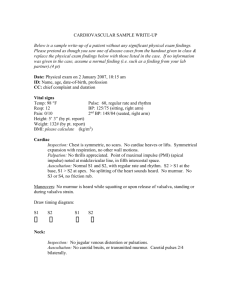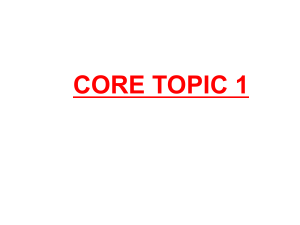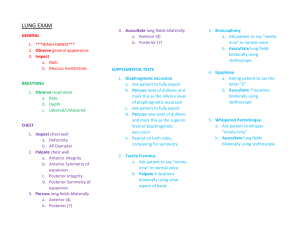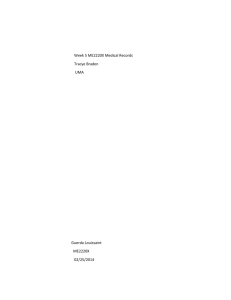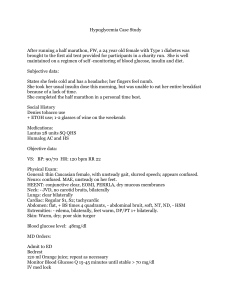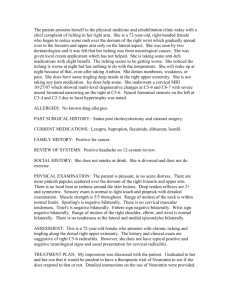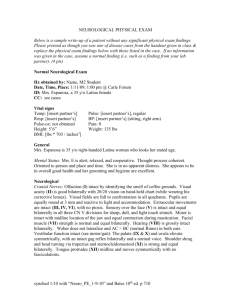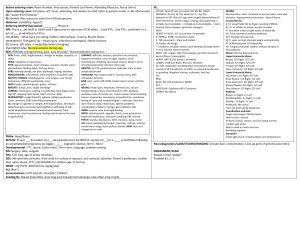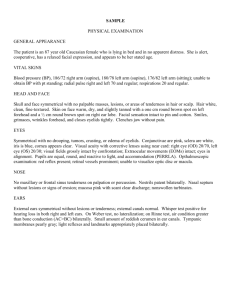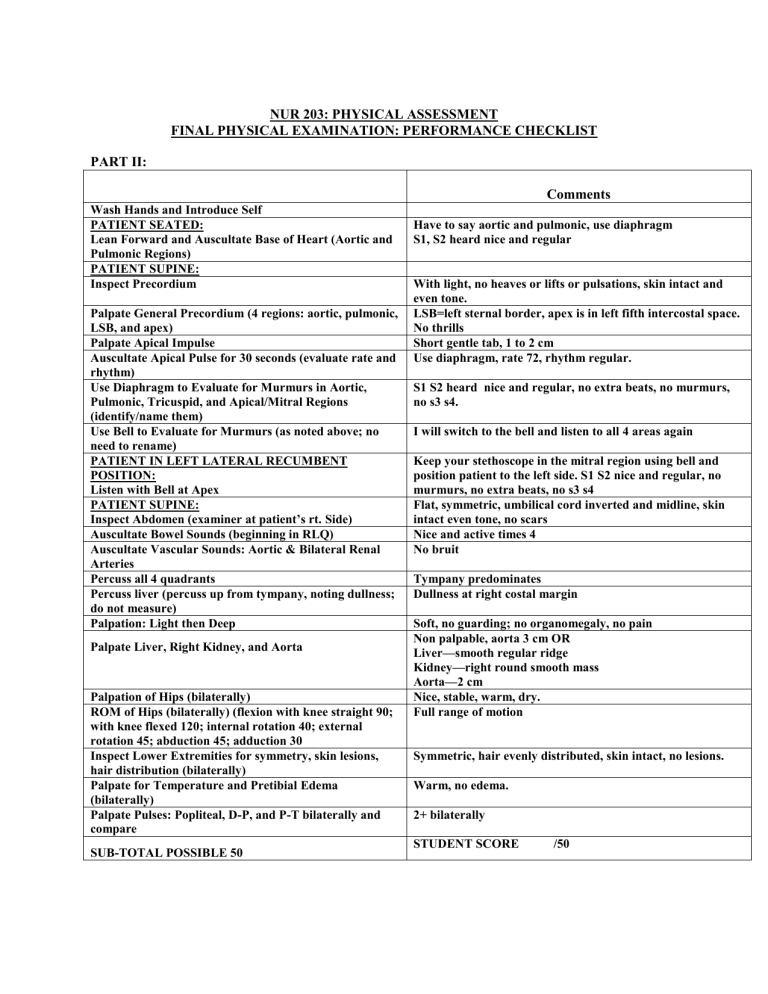
NUR 203: PHYSICAL ASSESSMENT FINAL PHYSICAL EXAMINATION: PERFORMANCE CHECKLIST PART II: Comments Wash Hands and Introduce Self PATIENT SEATED: Lean Forward and Auscultate Base of Heart (Aortic and Pulmonic Regions) PATIENT SUPINE: Inspect Precordium Palpate General Precordium (4 regions: aortic, pulmonic, LSB, and apex) Palpate Apical Impulse Auscultate Apical Pulse for 30 seconds (evaluate rate and rhythm) Use Diaphragm to Evaluate for Murmurs in Aortic, Pulmonic, Tricuspid, and Apical/Mitral Regions (identify/name them) Use Bell to Evaluate for Murmurs (as noted above; no need to rename) PATIENT IN LEFT LATERAL RECUMBENT POSITION: Listen with Bell at Apex PATIENT SUPINE: Inspect Abdomen (examiner at patient’s rt. Side) Auscultate Bowel Sounds (beginning in RLQ) Auscultate Vascular Sounds: Aortic & Bilateral Renal Arteries Percuss all 4 quadrants Percuss liver (percuss up from tympany, noting dullness; do not measure) Palpation: Light then Deep Palpate Liver, Right Kidney, and Aorta Palpation of Hips (bilaterally) ROM of Hips (bilaterally) (flexion with knee straight 90; with knee flexed 120; internal rotation 40; external rotation 45; abduction 45; adduction 30 Inspect Lower Extremities for symmetry, skin lesions, hair distribution (bilaterally) Palpate for Temperature and Pretibial Edema (bilaterally) Palpate Pulses: Popliteal, D-P, and P-T bilaterally and compare SUB-TOTAL POSSIBLE 50 Have to say aortic and pulmonic, use diaphragm S1, S2 heard nice and regular With light, no heaves or lifts or pulsations, skin intact and even tone. LSB=left sternal border, apex is in left fifth intercostal space. No thrills Short gentle tab, 1 to 2 cm Use diaphragm, rate 72, rhythm regular. S1 S2 heard nice and regular, no extra beats, no murmurs, no s3 s4. I will switch to the bell and listen to all 4 areas again Keep your stethoscope in the mitral region using bell and position patient to the left side. S1 S2 nice and regular, no murmurs, no extra beats, no s3 s4 Flat, symmetric, umbilical cord inverted and midline, skin intact even tone, no scars Nice and active times 4 No bruit Tympany predominates Dullness at right costal margin Soft, no guarding; no organomegaly, no pain Non palpable, aorta 3 cm OR Liver—smooth regular ridge Kidney—right round smooth mass Aorta—2 cm Nice, stable, warm, dry. Full range of motion Symmetric, hair evenly distributed, skin intact, no lesions. Warm, no edema. 2+ bilaterally STUDENT SCORE /50 PART II (continued): Comments PATIENT SITTING: Inspection and palpation of knees (bilaterally) (ROM is done later) Inspection and palpation of ankles and feet (bilaterally) ROM ankles/feet (bilaterally) (dorsiflexion 20; plantar flexion 45; eversion 20; inversion 30) Strength: dorsiflexion and plantar flexion against resistance (bilaterally) Separate Toes and Inspect Skin for lesions/rashes PATIENT SITTING: Sensory Function of CN V (cotton ball to 3 facial regions bilaterally) close eyes Sensation (Dull/Sharp) to Arms and Legs (all 4 extermeties) Position Sense of One Finger Bilaterally (kinesthesia) Stereognosis Bilaterally Graphesthesia Bilaterally Cerebellar Function Upper Ext: Rapid Alternating Movement (hand slap or thumb to fingers) Finger-to-Nose Test Cerebellar Function Lower Ext: Heel Down Shin DTRs Bilaterally (Name them): Biceps, Triceps, Brachioradialis, Patellar/Quadriceps, and Achilles Plantar Reflex/Babinski Sign Bilaterally PATIENT STANDING: Romberg (feet together; arms at sides; examiner stands close) Inspection of the hips (bilaterally) ROM of Knees bilaterally (hyperextension 15; flexion 130) ROM Spine: Flexion, Hyperextension, Bilateral Rotation, and Bilateral Lateral Bend/Tilt Scoliosis Evaluation (examiner positioned behind client; client’s back in flexion) General Gait Evaluation Tandem/Heel-Toe Walk ORGANIZATION Symmetric, skin intact, warm, dry, stable Stable, warm, dry, symmetric, skin intact Full range of motion 5+ strength Intact, no fungus, no lesions Able to feel sensations accurately in 6 places in the face. Able to accurately describe sensations Able to accurately identify the finger movements Able to accurately identify the object Able to accurately identify the numbers Smooth accurate coordinated movements Smooth accurate coordinated movements Smooth accurate coordinated movements Biceps 2+ bilaterally, Triceps 2+ bilaterally, Brachioradialis 2+ bilaterally, Patellar/Quadriceps 2+ bilaterally, and Achilles 2+ bilaterally Negative babinski Negative romberg Iliac crest symmetric, skin intact Full range of motion Full range of motion No scoliosis SUB-TOTAL POSSIBLE 50 STUDENT SCORE /50 TOTAL POSSIBLE 50 + 50 = 100 STUDENT SCORE /100
